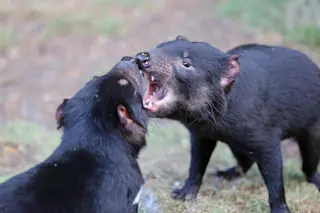Devil facial tumor disease (DFTD) spreads when Tasmanian devils nip at each other's faces — a common behavior in social interactions. (Credit: Bernhard Richter/Shutterstock) Tasmanian devils are knocked down — we’re talking a 9-count — but they aren’t out. Not yet. In just over 20 years, devil facial tumor disease (DFTD) has ravaged Tasmanian devils on the Australian island state, resulting in an 80 percent overall decline in the iconic species’ numbers. The transmissible cancer, distinguished by red, oozing facial tumors, is nearly 100 percent fatal, with most devils meeting their end within 6 months of contracting the disease. Based on statistical models, devil populations on the eastern edge of the island, where field researchers first detected the disease in 1996, should already be extinct, but that hasn’t happened. Instead small populations are still hanging on, because, as new evidence suggests, Tasmanian devils might be rapidly evolving resistance to their ...
Tasmanian Devils Are Rapidly Evolving Resistance to a Deadly Cancer
Devil facial tumor disease has decimated Tasmanian devil populations, but new research hints at evolving resistance, bringing hope for survival.
More on Discover
Stay Curious
SubscribeTo The Magazine
Save up to 40% off the cover price when you subscribe to Discover magazine.
Subscribe













